#lila nava
Text








#the sims 4#sims 4#ts4#high school years#daniella torrez#lucy torrez#oscar torrez#felix torrez#maribel torrez#lila nava#art torrez
116 notes
·
View notes
Text
Afghanistan is a country that is often associated with Islam, war, and violence. However, there is another side to this land that is rich in history, culture, and diversity. Afghanistan was once home to a vibrant and flourishing Hindu civilization that left behind many traces and impressions in the population, language, religion, and heritage of the country. This article will explore some of the aspects of the Hindu past in Afghanistan, and how they are still visible or relevant today.
Received message. A possible introduction for the above article is: Afghanistan is a country that is often associated with Islam, war, and violence. However, there is another side to this land that is rich in history, culture, and diversity. Afghanistan was once home to a vibrant and flourishing Hindu civilization that left behind many traces and impressions in the population, language, religion, and heritage of the country. This article will explore some of the aspects of the Hindu past in Afghanistan, and how they are still visible or relevant today.
Hindu Past in Afghanistan
Some of the impressions of the Hindu past still seen in the population of Afghanistan are:
Genetic and linguistic traces: According to some studies, some Afghan ethnic groups, such as the Pashtuns, have genetic and linguistic links to the Indo-Aryan peoples who inhabited the region in ancient times. The Pashto language, which is spoken by most Afghans, belongs to the Indo-Iranian branch of the Indo-European language family and has many words derived from Sanskrit, the ancient language of Hinduism. Some Pashtun tribes also claim descent from Hindu or Buddhist ancestors, such as the Afridi tribe, which traces its origin to Ashvaka, a Sanskrit term for horsemen
Cultural and religious influences: Some aspects of Afghan culture and religion have been influenced by Hinduism over the centuries. For example, some Afghan names, such as Ram, Lila, Ravi, Raju, etc., are of Hindu origin. Some Afghan festivals, such as Nawroz (New Year), Basant (Spring Festival), and Shab-e-Barat (Night of Forgiveness), have similarities with Hindu festivals such as Holi, Vasant Panchami, and Diwali. Some Afghan Muslims also visit Hindu shrines or holy places, such as the shrine of Ganesha in Gardez, the temple of Nava Durga in Kabul, or the cave of Zunbils in Ghazni. Some Afghan Muslims also believe in reincarnation, karma, and astrology, which are concepts associated with Hinduism
Historical and archaeological evidence: Some historical and archaeological evidence of the Hindu past can be seen in Afghanistan. For example, some ancient Hindu kingdoms and dynasties, such as the Kambojas, the Gandharas, the Kushans, the Turk Shahis, and the Hindu Shahis, ruled over parts of Afghanistan from the 2nd millennium BCE to the 10th century CE. They left behind coins, inscriptions, sculptures, temples, and monuments that testify to their presence and influence. Some of these remains can be seen in museums or sites such as Kabul Museum, Bamiyan Valley, Hadda Stupa Complex, Surkh Kotal Temple Complex, and Tepe Narenj Monastery Complex
These are some of the impressions of the Hindu past still seen in the population of Afghanistan, but they are not very prominent or widely recognized by most Afghans or outsiders.
Hindu Shahis Culture Art Architecture
Some of the rich legacies left by the Hindu Shahis are:
Coinage: The Hindu Shahis issued gold, silver, and copper coins that bore their names, titles, dates, and religious symbols. The coins were influenced by the Kushan, Sasanian, and Turkic styles, but also had distinctive features such as the recumbent bull, the horseman, and the Nagari script. The coins provide valuable information about the chronology, geography, and culture of the Hindu Shahis
Temples: The Hindu Shahis built many temples in their domains, especially in Kabul, Udabhandapura, and Lahore. The temples reflected their Hindu faith and identity, as well as their artistic and a
rchitectural skills. The temples were decorated with sculptures, carvings, and paintings of various deities, scenes from Hindu mythology, and inscriptions. Some of the temples also served as royal mausoleums. The temples followed the Gandhara-Nagara style of architecture, which developed distinct formulations under the Hindu Shahis. A typical Hindu Shahi temple had two ground-level chambers embedded within a tower—leading to a minaret-like appearance—with an ambulatory at the top, that was accessible by a stairwell
Sculpture: The Hindu Shahis produced many sculptures in stone, metal, and terracotta, depicting various aspects of their religion and culture. The sculptures ranged from small figurines to large statues and were influenced by the Gandhara, Gupta, and Kashmiri styles. The sculptures portrayed Hindu gods and goddesses, such as Shiva, Vishnu, Ganesha, Durga, and Lakshmi, as well as Buddhist icons such as Buddha and Bodhisattvas. The sculptures also depicted animals, birds, flowers, musicians, dancers, and warriors. Some of the sculptures were found in temples, while others were placed in public places or private homes
Forts and settlements: The Hindu Shahis built many forts and settlements to protect their territories and administer their affairs. The forts were strategically located on hills or mountains, overlooking rivers or valleys. They were fortified with walls, towers, gates, and moats. They also had palaces, barracks, storerooms, wells, and temples inside them. The settlements were planned according to the principles of Vaastu Shastra and Shilpa Shastra, which are ancient Indian texts on architecture and design. The settlements had roads, markets, houses, gardens, ponds, and shrines. They also had schools, libraries, hospitals, and courts
These are some of the rich legacies left by the Hindu Shahis that show their contribution to the history and culture of Afghanistan and India.
Hindu Population Conversion to Islam in Afghanistan
The conversion of the Hindu population to Islam in Afghanistan was a gradual and complex process that involved various factors such as political, economic, social, and cultural influences. According to some sources, some of the reasons for the conversion were:
Military conquest and pressure: The Muslim invaders, such as the Arabs, Turks, Mongols, and Ghaznavids, who conquered parts of Afghanistan from the 7th to the 13th centuries, imposed their rule and religion on the local population. They often destroyed Hindu temples, shrines, and idols, and imposed taxes (jizya) and restrictions on non-Muslims. They also offered incentives and privileges to those who converted to Islam, such as land grants, protection, and exemption from taxes. Some Hindus converted to Islam to avoid persecution, discrimination, or violence, or to gain social and economic benefits
Sufism and missionary activities: The Muslim mystics, known as Sufis, played a significant role in spreading Islam in Afghanistan through their preaching, teaching, and charitable works. They attracted many followers from different backgrounds, including Hindus, Buddhists, and Zoroastrians, by offering a more tolerant and inclusive version of Islam that emphasized love, devotion, and personal experience of God. They also established hospices (khanqahs), schools (madrasas), and shrines (ziarat) that served as centers of learning and worship for the local communities. Some of the famous Sufis who influenced Afghanistan were Ali al-Hujwiri (Data Ganj Bakhsh), Ahmad al-Ghazali, Khwaja Abdullah Ansari, Moinuddin Chishti, and Bahauddin Naqshband
Cultural assimilation and syncretism: The Muslim invaders and settlers brought with them their own languages, customs, arts, and sciences that influenced the Afghan culture. Many Hindus adopted Arabic or Persian names, dress, food, and music. They also learned Arabic or Persian languages and literature, which were the mediums of education and administr
ation. Some aspects of Hindu culture, such as festivals, rituals, and legends, were also incorporated into Islam or adapted to suit the new context. For example, some Hindu gods and goddesses were revered as saints or prophets by some Muslims. Some Hindus also retained their caste identities or practices within Islam
These are some of the possible explanations for how the Hindu population converted to Islam in Afghanistan after the fall of the Hindu Shahi dynasty. However, it is important to note that the conversion was not uniform or complete, as some Hindus resisted or maintained their faith in secret or in remote areas. Moreover, the conversion was not always forced or coerced, as some Hindus voluntarily embraced Islam out of conviction or curiosity. Therefore, the conversion should be understood as a dynamic and diverse phenomenon that varied according to time, place, and circumstance.
Hindu Resistance to Conversion in Afghanistan
There are some stories about resistance to conversion in Afghanistan, but they are not very well documented or widely known. Some of the examples are:
The legend of Ganesha: According to a popular legend, the Hindu god Ganesha was once worshipped in a temple in Gardez, a city in eastern Afghanistan. When the Muslim invaders attacked the temple, Ganesha took the form of a boy and fought them with his trunk. He killed many of them but was eventually captured and taken to their camp. There, he revealed his true identity and cursed them with a plague. The invaders fled in fear and left the temple intact. The statue of Ganesha from Gardez is now attributed to the period of Turk Shahis in the 7-8th century CE
The Rebellion of Kabul: In 1504 CE, the Mughal emperor Babur conquered Kabul and imposed Islam on the Hindu population. However, some Hindus refused to convert and rebelled against his rule. They formed a secret society called the Lohani, which means “iron” in Pashto. They wore iron rings on their fingers as a sign of their loyalty to their faith and their resistance to the Mughals. They also engaged in guerrilla warfare and assassinations against the Mughal officials and soldiers. The Lohani rebellion lasted for about 40 years until it was finally crushed by Babur’s grandson Akbar
The martyrdom of Teja Singh: In 1832 CE, a Sikh leader named Teja Singh was captured by the Afghan ruler Dost Mohammad Khan during a battle near Jalalabad. He was offered a choice between conversion to Islam or death. He chose death and was executed by being blown by a cannon. His sacrifice inspired many Sikhs and Hindus to resist Afghan oppression and fight for their freedom. Teja Singh is revered as a martyr by the Afghan Sikhs and Hindus, who visit his shrine in Jalalabad every year
The Last Hindu King of Afghanistan
The year was 1001 CE. The Hindu Shahis, a dynasty that ruled over Kabul, Gandhara, and western Punjab for nearly two centuries, were facing their greatest challenge yet. The Ghaznavids, a powerful Muslim empire that had conquered most of Central Asia and Iran, had launched a massive invasion of their lands, led by their ambitious sultan Mahmud of Ghazni.
The Hindu Shahi king, Jayapala, was determined to resist the invaders and defend his ancestral domains. He gathered a large army of his own warriors, as well as allies from other Hindu kingdoms such as the Pratiharas, the Tomaras, and the Utpalas. He also sought help from the Buddhist rulers of Kashmir and Tibet, who shared his concern about the Islamic expansion.
The two armies met at the battle of Peshawar, near the Indus River. The Hindu Shahis fought bravely, but they were outnumbered and outmatched by the Ghaznavids, who had superior weapons, horses, and tactics. The battle turned into a massacre, as thousands of Hindu soldiers were slain or captured by the enemy. Jayapala himself was wounded and taken prisoner by Mahmud.
Mahmud treated his captive with respect and offered him generous terms for
his release. He asked Jayapala to acknowledge him as his overlord and pay him a tribute of gold and jewels. Jayapala agreed to these conditions, hoping to save his kingdom from further destruction.
However, when he returned to the capital of Udabhandapura (modern Und), he faced the wrath of his subjects and nobles. They accused him of cowardice and treason for surrendering to the Muslims. They also blamed him for the loss of their lands, wealth, and honor. They demanded that he abdicate his throne and make way for a new ruler who could restore their glory.
Jayapala was heartbroken by this betrayal. He felt that he had no choice but to end his life. He built a huge funeral pyre and set himself on fire, along with his family and loyal followers. He died as a martyr, hoping that his sacrifice would inspire his people to fight.
He was succeeded by his son Anandapala, who continued the struggle against the Ghaznavids. He managed to recapture some of the lost territories, but he could not stop Mahmud’s raids and plundering. He died in 1010 CE, after another defeat at the battle of Ohind.
The Hindu Shahi dynasty gradually declined and collapsed under the pressure of the Ghaznavids and other Muslim invaders. The last Hindu king of Afghanistan was Trilochanapala, who was killed in 1026 CE by Mahmud’s son Mas’ud I.
The Hindu Shahis left behind a rich legacy of culture, art, and architecture in their former domains. They built many temples, palaces, and monuments that reflected their Hindu faith and identity. They also patronized literature, science, and education, and preserved the ancient heritage of Gandhara and Kabulistan. They were remembered as brave and noble rulers who resisted foreign invaders with courage and dignity.
Conclusion
The Hindu past in Afghanistan is a fascinating and often overlooked aspect of the country’s history and culture. It shows that Afghanistan was not always a monolithic or homogeneous society, but rather a diverse and dynamic one that was influenced by various civilizations and religions. The Hindu past also reveals the resilience and creativity of the Afghan people, who have preserved or adapted some elements of their ancestral faith in the face of challenges and changes. The Hindu past in Afghanistan is a valuable and precious legacy that deserves to be recognized, respected, and protected by all.
Handicrafts Paradise Resin Standing Krishna Idol (6.4 cm x 3.8 cm x 14.6 cm)
0 notes
Text
Afghanistan is a country that is often associated with Islam, war, and violence. However, there is another side to this land that is rich in history, culture, and diversity. Afghanistan was once home to a vibrant and flourishing Hindu civilization that left behind many traces and impressions in the population, language, religion, and heritage of the country. This article will explore some of the aspects of the Hindu past in Afghanistan, and how they are still visible or relevant today.
Received message. A possible introduction for the above article is: Afghanistan is a country that is often associated with Islam, war, and violence. However, there is another side to this land that is rich in history, culture, and diversity. Afghanistan was once home to a vibrant and flourishing Hindu civilization that left behind many traces and impressions in the population, language, religion, and heritage of the country. This article will explore some of the aspects of the Hindu past in Afghanistan, and how they are still visible or relevant today.
Hindu Past in Afghanistan
Some of the impressions of the Hindu past still seen in the population of Afghanistan are:
Genetic and linguistic traces: According to some studies, some Afghan ethnic groups, such as the Pashtuns, have genetic and linguistic links to the Indo-Aryan peoples who inhabited the region in ancient times. The Pashto language, which is spoken by most Afghans, belongs to the Indo-Iranian branch of the Indo-European language family and has many words derived from Sanskrit, the ancient language of Hinduism. Some Pashtun tribes also claim descent from Hindu or Buddhist ancestors, such as the Afridi tribe, which traces its origin to Ashvaka, a Sanskrit term for horsemen
Cultural and religious influences: Some aspects of Afghan culture and religion have been influenced by Hinduism over the centuries. For example, some Afghan names, such as Ram, Lila, Ravi, Raju, etc., are of Hindu origin. Some Afghan festivals, such as Nawroz (New Year), Basant (Spring Festival), and Shab-e-Barat (Night of Forgiveness), have similarities with Hindu festivals such as Holi, Vasant Panchami, and Diwali. Some Afghan Muslims also visit Hindu shrines or holy places, such as the shrine of Ganesha in Gardez, the temple of Nava Durga in Kabul, or the cave of Zunbils in Ghazni. Some Afghan Muslims also believe in reincarnation, karma, and astrology, which are concepts associated with Hinduism
Historical and archaeological evidence: Some historical and archaeological evidence of the Hindu past can be seen in Afghanistan. For example, some ancient Hindu kingdoms and dynasties, such as the Kambojas, the Gandharas, the Kushans, the Turk Shahis, and the Hindu Shahis, ruled over parts of Afghanistan from the 2nd millennium BCE to the 10th century CE. They left behind coins, inscriptions, sculptures, temples, and monuments that testify to their presence and influence. Some of these remains can be seen in museums or sites such as Kabul Museum, Bamiyan Valley, Hadda Stupa Complex, Surkh Kotal Temple Complex, and Tepe Narenj Monastery Complex
These are some of the impressions of the Hindu past still seen in the population of Afghanistan, but they are not very prominent or widely recognized by most Afghans or outsiders.
Hindu Shahis Culture Art Architecture
Some of the rich legacies left by the Hindu Shahis are:
Coinage: The Hindu Shahis issued gold, silver, and copper coins that bore their names, titles, dates, and religious symbols. The coins were influenced by the Kushan, Sasanian, and Turkic styles, but also had distinctive features such as the recumbent bull, the horseman, and the Nagari script. The coins provide valuable information about the chronology, geography, and culture of the Hindu Shahis
Temples: The Hindu Shahis built many temples in their domains, especially in Kabul, Udabhandapura, and Lahore. The temples reflected their Hindu faith and identity, as well as their artistic and a
rchitectural skills. The temples were decorated with sculptures, carvings, and paintings of various deities, scenes from Hindu mythology, and inscriptions. Some of the temples also served as royal mausoleums. The temples followed the Gandhara-Nagara style of architecture, which developed distinct formulations under the Hindu Shahis. A typical Hindu Shahi temple had two ground-level chambers embedded within a tower—leading to a minaret-like appearance—with an ambulatory at the top, that was accessible by a stairwell
Sculpture: The Hindu Shahis produced many sculptures in stone, metal, and terracotta, depicting various aspects of their religion and culture. The sculptures ranged from small figurines to large statues and were influenced by the Gandhara, Gupta, and Kashmiri styles. The sculptures portrayed Hindu gods and goddesses, such as Shiva, Vishnu, Ganesha, Durga, and Lakshmi, as well as Buddhist icons such as Buddha and Bodhisattvas. The sculptures also depicted animals, birds, flowers, musicians, dancers, and warriors. Some of the sculptures were found in temples, while others were placed in public places or private homes
Forts and settlements: The Hindu Shahis built many forts and settlements to protect their territories and administer their affairs. The forts were strategically located on hills or mountains, overlooking rivers or valleys. They were fortified with walls, towers, gates, and moats. They also had palaces, barracks, storerooms, wells, and temples inside them. The settlements were planned according to the principles of Vaastu Shastra and Shilpa Shastra, which are ancient Indian texts on architecture and design. The settlements had roads, markets, houses, gardens, ponds, and shrines.��They also had schools, libraries, hospitals, and courts
These are some of the rich legacies left by the Hindu Shahis that show their contribution to the history and culture of Afghanistan and India.
Hindu Population Conversion to Islam in Afghanistan
The conversion of the Hindu population to Islam in Afghanistan was a gradual and complex process that involved various factors such as political, economic, social, and cultural influences. According to some sources, some of the reasons for the conversion were:
Military conquest and pressure: The Muslim invaders, such as the Arabs, Turks, Mongols, and Ghaznavids, who conquered parts of Afghanistan from the 7th to the 13th centuries, imposed their rule and religion on the local population. They often destroyed Hindu temples, shrines, and idols, and imposed taxes (jizya) and restrictions on non-Muslims. They also offered incentives and privileges to those who converted to Islam, such as land grants, protection, and exemption from taxes. Some Hindus converted to Islam to avoid persecution, discrimination, or violence, or to gain social and economic benefits
Sufism and missionary activities: The Muslim mystics, known as Sufis, played a significant role in spreading Islam in Afghanistan through their preaching, teaching, and charitable works. They attracted many followers from different backgrounds, including Hindus, Buddhists, and Zoroastrians, by offering a more tolerant and inclusive version of Islam that emphasized love, devotion, and personal experience of God. They also established hospices (khanqahs), schools (madrasas), and shrines (ziarat) that served as centers of learning and worship for the local communities. Some of the famous Sufis who influenced Afghanistan were Ali al-Hujwiri (Data Ganj Bakhsh), Ahmad al-Ghazali, Khwaja Abdullah Ansari, Moinuddin Chishti, and Bahauddin Naqshband
Cultural assimilation and syncretism: The Muslim invaders and settlers brought with them their own languages, customs, arts, and sciences that influenced the Afghan culture. Many Hindus adopted Arabic or Persian names, dress, food, and music. They also learned Arabic or Persian languages and literature, which were the mediums of education and administr
ation. Some aspects of Hindu culture, such as festivals, rituals, and legends, were also incorporated into Islam or adapted to suit the new context. For example, some Hindu gods and goddesses were revered as saints or prophets by some Muslims. Some Hindus also retained their caste identities or practices within Islam
These are some of the possible explanations for how the Hindu population converted to Islam in Afghanistan after the fall of the Hindu Shahi dynasty. However, it is important to note that the conversion was not uniform or complete, as some Hindus resisted or maintained their faith in secret or in remote areas. Moreover, the conversion was not always forced or coerced, as some Hindus voluntarily embraced Islam out of conviction or curiosity. Therefore, the conversion should be understood as a dynamic and diverse phenomenon that varied according to time, place, and circumstance.
Hindu Resistance to Conversion in Afghanistan
There are some stories about resistance to conversion in Afghanistan, but they are not very well documented or widely known. Some of the examples are:
The legend of Ganesha: According to a popular legend, the Hindu god Ganesha was once worshipped in a temple in Gardez, a city in eastern Afghanistan. When the Muslim invaders attacked the temple, Ganesha took the form of a boy and fought them with his trunk. He killed many of them but was eventually captured and taken to their camp. There, he revealed his true identity and cursed them with a plague. The invaders fled in fear and left the temple intact. The statue of Ganesha from Gardez is now attributed to the period of Turk Shahis in the 7-8th century CE
The Rebellion of Kabul: In 1504 CE, the Mughal emperor Babur conquered Kabul and imposed Islam on the Hindu population. However, some Hindus refused to convert and rebelled against his rule. They formed a secret society called the Lohani, which means “iron” in Pashto. They wore iron rings on their fingers as a sign of their loyalty to their faith and their resistance to the Mughals. They also engaged in guerrilla warfare and assassinations against the Mughal officials and soldiers. The Lohani rebellion lasted for about 40 years until it was finally crushed by Babur’s grandson Akbar
The martyrdom of Teja Singh: In 1832 CE, a Sikh leader named Teja Singh was captured by the Afghan ruler Dost Mohammad Khan during a battle near Jalalabad. He was offered a choice between conversion to Islam or death. He chose death and was executed by being blown by a cannon. His sacrifice inspired many Sikhs and Hindus to resist Afghan oppression and fight for their freedom. Teja Singh is revered as a martyr by the Afghan Sikhs and Hindus, who visit his shrine in Jalalabad every year
The Last Hindu King of Afghanistan
The year was 1001 CE. The Hindu Shahis, a dynasty that ruled over Kabul, Gandhara, and western Punjab for nearly two centuries, were facing their greatest challenge yet. The Ghaznavids, a powerful Muslim empire that had conquered most of Central Asia and Iran, had launched a massive invasion of their lands, led by their ambitious sultan Mahmud of Ghazni.
The Hindu Shahi king, Jayapala, was determined to resist the invaders and defend his ancestral domains. He gathered a large army of his own warriors, as well as allies from other Hindu kingdoms such as the Pratiharas, the Tomaras, and the Utpalas. He also sought help from the Buddhist rulers of Kashmir and Tibet, who shared his concern about the Islamic expansion.
The two armies met at the battle of Peshawar, near the Indus River. The Hindu Shahis fought bravely, but they were outnumbered and outmatched by the Ghaznavids, who had superior weapons, horses, and tactics. The battle turned into a massacre, as thousands of Hindu soldiers were slain or captured by the enemy. Jayapala himself was wounded and taken prisoner by Mahmud.
Mahmud treated his captive with respect and offered him generous terms for
his release. He asked Jayapala to acknowledge him as his overlord and pay him a tribute of gold and jewels. Jayapala agreed to these conditions, hoping to save his kingdom from further destruction.
However, when he returned to the capital of Udabhandapura (modern Und), he faced the wrath of his subjects and nobles. They accused him of cowardice and treason for surrendering to the Muslims. They also blamed him for the loss of their lands, wealth, and honor. They demanded that he abdicate his throne and make way for a new ruler who could restore their glory.
Jayapala was heartbroken by this betrayal. He felt that he had no choice but to end his life. He built a huge funeral pyre and set himself on fire, along with his family and loyal followers. He died as a martyr, hoping that his sacrifice would inspire his people to fight.
He was succeeded by his son Anandapala, who continued the struggle against the Ghaznavids. He managed to recapture some of the lost territories, but he could not stop Mahmud’s raids and plundering. He died in 1010 CE, after another defeat at the battle of Ohind.
The Hindu Shahi dynasty gradually declined and collapsed under the pressure of the Ghaznavids and other Muslim invaders. The last Hindu king of Afghanistan was Trilochanapala, who was killed in 1026 CE by Mahmud’s son Mas’ud I.
The Hindu Shahis left behind a rich legacy of culture, art, and architecture in their former domains. They built many temples, palaces, and monuments that reflected their Hindu faith and identity. They also patronized literature, science, and education, and preserved the ancient heritage of Gandhara and Kabulistan. They were remembered as brave and noble rulers who resisted foreign invaders with courage and dignity.
Conclusion
The Hindu past in Afghanistan is a fascinating and often overlooked aspect of the country’s history and culture. It shows that Afghanistan was not always a monolithic or homogeneous society, but rather a diverse and dynamic one that was influenced by various civilizations and religions. The Hindu past also reveals the resilience and creativity of the Afghan people, who have preserved or adapted some elements of their ancestral faith in the face of challenges and changes. The Hindu past in Afghanistan is a valuable and precious legacy that deserves to be recognized, respected, and protected by all.
Handicrafts Paradise Resin Standing Krishna Idol (6.4 cm x 3.8 cm x 14.6 cm)
0 notes
Note
hello! do you have any suggestions for a trans latina fc? tysm!
Roberta Close (1964) Brazilian.
Alejandra Bogue (1965) Mexican.
Lizy Tagliani (1970) Argentinian.
Topacio Fresh (1973) Argentinian.
Delilah Kotero / Vaniity (1973) Purépecha Mexican.
Maria Clara Spinelli (1975) Brazilian [Italian].
Endry Cardeño (1975) Colombian.
Lea T (1981) Brazilian.
Carmen Carrera (1985) Puerto Rican / Peruvian.
Elysia Crampton (1986) Aymara Bolivian.
Nomi Ruiz (1986) Puerto Rican.
Zemmoa (1986) Mexican.
Leiomy Maldonado (1987) Afro-Puerto Rican.
Daniela Vega (1989) Chilean.
Linn da Quebrada (1990) Afro-Brazilian.
Thiessa Woinbackk (1990) Brazilian.
Cinthya Carmona (1990) Venezuelan.
Harmony Santana (1991) Afro- Dominican and Puerto Rican.
Michaela Jaé Rodriguez (1991) African-American, one quarter Puerto Rican.
Laxie Beth (1991) Venezuelan.
Victoria Volkova (1992) Mexican.
Lux Pascal (1992) Chilean.
Isabella Santiago (1992) Venezuelan.
Anahi Altuzar (1993) Mexican.
Eden Estrada (1995) Mexican.
Liniker (1995) Afro-Brazilian - genderfluid trans woman.
Zión Moreno (1995) Mexican [Unspecified Native American and Spanish].
Valentina Sampaio (1996) Brazilian.
Mareya Salazar (1996) Venezuelan / Black Canadian.
Trinity Anne (1998) Mexican.
Zoey Luna (2001) Mexican.
Selyna Brillare (2001) Afro-Dominican.
Aaron Philip (2001) Afro-Antiguan - has cerebral palsy.
Nava Mau (?) Mexican.
Victória Carioni (?) Brazilian.
Carolina Gutierrez (?) Colombian.
Chaska Sofia / DJ Precolumbian (?) Afro Peruvian and Quechua - genderqueer trans woman.
CeCe Suazo (?) Afro- Honduran and Cuban.
Lila Martinez / Lila Star / Lila Star Escada (?) Unspecified Laitne.
Ayelen Beker (?) Argentinian.
Marina Matheus (?) Brazilian.
Amar Sotomayor (?) Afro-Puerto Rican.
Carlie Guevara (?) Mexican.
Danna Sultana (?) Colombian.
Juana Jiménez (?) Colombian.
Xemi Manibusa (?) Salvadoran [Pipil, Sephardi Jewish, and Spanish] - non-binary and two-spirit trans womxn.
Here you go - updated my trans faceclaim masterlist too!
22 notes
·
View notes
Text
TARDES DE JUTICALPA
Paca Navas de Miralda
Se ha teñido el ocaso con fulgores de llama
que dora el terciopelo verde de las colinas
y en la ciudad vetusta se difunde la gama
crepuscular,en ondas vividas,diamantinas,
El silencio deambula por las calles desiertas
frente al parque se yergue la antigua catedral
bajo cuyas ojibas rastro de edades muertas
enseñan las golondrinas en la calma estival.
En la hora del "Angelus" la del pensar"profundo"
la que transforma en un Augusto templo el mundo
el aire huele a nardos,rosas y limonarias.
Arriba brilla el véspero entre celajes lilas
desgranan lentamente tu canción las esquinas
y el alma de la tarde musita su plegaria

0 notes
Text
Indische Festivals
Navratri Festival
Ich bin hier in Indien angekommen und erlebe schon die volle Festivalpracht, ein Festival folgt dem anderen, viele Menschen sind am feiern und tanzen.
Navratri ist ein neun Tage langes Hindu Festival welches in allen Regionen Indiens anders zelebriert wird. „Nava" heißt übersetzt Neun und „ratri" Nacht in Sanskrit. Es wird der Göttin Durga gehuldigt und ihrer neun Inkarnationen: Siddhidatri, Kushmanda, Brahmacharini, Shailputri, Mahagauri, Chandraghanta, Skandamata, Katyayani und Kalaratri. In diesem Jahr war der erste Tag der 21. September und die Navratri Farbe des Tages war Gelb. Denn jeden Tag wird eine andere Farbe getragen die sich vor allem in den Sarees der Frauen widerspiegelt. Die folgenden Farben waren Grün, Grau, Organe, Weiß, Rot, Royal Blau, Pink und Lila. Leider hab ich das mit den wechselten Farben erst an dem Tag mitbekommen wo mir aufgefallen ist das mehrere Pink trugen. Aber ich hätte wahrscheinlich eh nicht mitmachen können, weil ich ja hier nur eine sehr beschränkte Auswahl von Kleidung habe. Das ist auf jeden Fall ein Grund mehr von diesen wunderschönen Farben Indiens in meinen Kleiderschrank zu bekommen!
Am letzten Schultag an diesem Festival waren auch alle Kinder wunderschön gekleidet und wir tanzten alle zusammen auf dem Schulhof. Am Freitagabend, an dem die Navratri Farbe des Tages Lila war nahmen mich Bindu und Apeksha mit zu einer Gebetsstätte an der die Göttin Durga als große Startur prangte und ihre neun Inkarnationen als Feuerstellen symbolisiert waren. Ausserdem gab es kostenloses Essen, weswegen sich eine große Traube von Menschen davor versammelten. Wir gingen zu der Startur und ließen uns von einem Mann ein Bindi auf die Stirn malen und nahmen Süßigkeiten entgegen. Dann gingen wir drei Runden um die neun Feuerstellen herum und beteten. Viele Inderinnen und Inder rasten an mir vorbei, ich musste ersteinmal im meinem Kopf sortieren zu was und über was ich eigentlich beten wollte. Die Süßigkeiten blieben derweil immer in der Hand und wir assen sie erst als wir das Anwesen verließen.
Am Samstag gab es dann ein Fest in der Schule, von den Eltern für die Eltern organisiert. Dort lernte ich ein wenig den traditionellen Tanz Dandiya Raas.
Die Kinder, die Lehrerinnen und Lehrer, alle beim tanzenauf dem Schulhof!
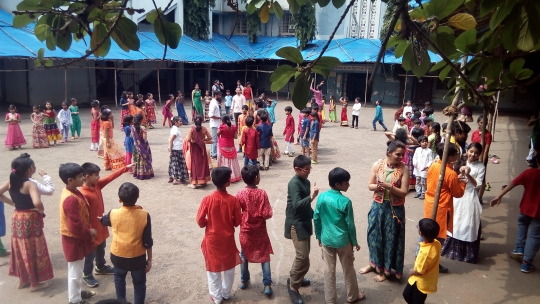
Die Gebetsstätte. Und wir laufen im Viereck.

Die Kinder beim traditionellen Stocktanz Dandiya Raas:
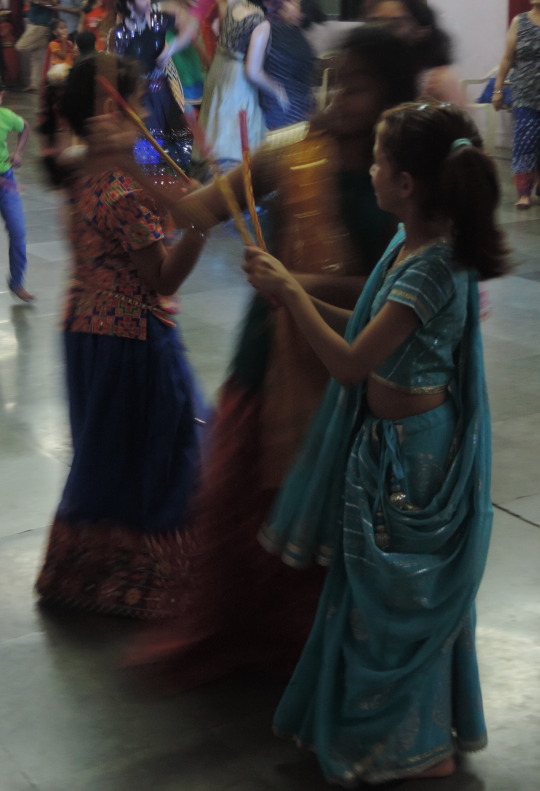
Diwali Festival
Diwali ist eins der größten und wichtigsten Feste des Hinduismus. Es wir auch das Lichterfest genannt und die Familien feiern es hier in dem sie sich gegenseitig beschenken, gutes Essen zubereiten, beten, singen und am wichtigsten das ganze Haus mit Mandalas und Lichterketten schmücken. Diwali war dieses Jahr am 19. Oktober und anlässlich dazu gab es zwei Wochen Diwaliferien für meine Schule. Wir feierten das Fest dementsprechend vor und veranstalteten ein Aufführung am ersten Feriensamstag in der Schule. Schon am Freitag waren alle Kinder festlich gekleidet und unsere Räume wurden geschmückt mit Laterne, Blumen und Mandalas an den Türeingängen. Am Samstag der zeigten alle von der 2. bis zur 7. Klasse etwas aus dem Unterricht auf der Bühne vor, was mich stark an die Monatsfeiern meiner vergangen Schulzeit erinnern ließ. Doch es gab einen ganz entscheidenden Unterschied und das war die Kleidung! Den alle Kinder waren in schillernden Farben gekleidet und auch alle Lehrerinnen vereinbarten Saree zu tragen. Alle waren so atemberaubend schön!
Die erste Klasse nahm nach den Aufführungen der Älteren und einer kurzen Essenspause an einer ganz besondern Zeremonie teil. Der Lichtspirale, die groß und begehbar auf dem Boden mit Blumen und Lichtern gestaltet wurde. Diese Zeremonie habe ich selbst in meiner Waldorfkariere miterleben dürfen. In den christlich geprägten Regionen wird diese Spirale zelebriert um mit den Kindern den Anfang der Adventszeit zufeiern. In der Mitte steht eine große Kerze und jedes Kind darf in die Spirale hinein gehen und eine eigene kleine Kerze entzünden und mit diesem neugewonnen Licht die Spirale wieder verlassen. Bei uns hier in Indien hatten wir kleine Öllämpchen die auch Diya genannt werden und während alle 25 Kinder in die Spirale gingen und wieder hinaus sangen die Eltern, Lehrerinnen und Lehrer zusammen ein Lied. Ich bekam mehrmal Gänsehaut weil dieser Moment einfach so faszinierend schön aussah!
Wer nachmal etwas mehr über die Lichterspirale lesen möchte empfehle ich diese Webseite: http://www.erziehungskunst.de/artikel/fruehe-kindheit/die-lichtspirale-ueber-das-adventgaertlein/
Wir machten alle zusammen dann natürlich noch ein Gruppenfoto. :)
Diwali war am 19. Oktober und durfte ich bei meiner ersten Gastfamilie miterleben. Alle hatten sich etwas schönes angezogen, räumten die Wohnung auf und stellten in jedes Zimmer an die Fenster Diyas. Naomi und ich gestalteten ein kleines Mandala aus Blumen auf dem Boden, welches normalerweise oft mit feinen Sand oder Pulver gemacht wird. Zunächst saßen wir alle gemütlich zusammen und dann begann eine kleine Zeremonie. Wir setzten uns auf dem Boden, alle um einen kleinen Tisch der mit Blumen geschmückt war. Auf dem Tischchen brannte eine Dia und Süßigkeiten waren darum gelegt. Apeksha hatte ein kleines Gebetbuch und sie sang die Gebete auf Sanskrit vor. Alle klatschten im Rhythmus und Jagan läutete eine kleine Glocke. Da die Wohnungstür währenddessen offen stand kamen auch Freund und Nachbarn und setzten sich dazu. Als das Gebet zu ende war hielten wir einen Moment der Stille und aßen anschließend die Süßigkeiten. Mit Naomi, Jagan, Madhav und zwei Freundinnen von Naomi gingen wir dann zu einem Hindu Tempel um zu beten. Wir nahem Kerzen etwas Geld und für jeden eine Kopfbedeckung mit. Vor dem Tempel zogen wir unsere Schuhe aus legten das Kopftuch um und gingen in die Halle. Die Frauen standen links und die Männer rechts. Ein Mann sprach vorne ein Gebet und an bestimmten Passagen gingen alle auf die Knie und berührten mit der Stirn den Boden. Der Moment in dem Tempel war sehr schnell vorbei und da ich auch aufgeregt war konnte ich mir gar keine richtigen Gedanken für ein Gebet überlegen. Als wir den Tempel verließen zündeten wir draußen unsere Kerzen an und stellten sie zu den vielen anderen. Wieder zu Hause gab es wunderbare leckeres Essen. Draußen wurden am Tag wie auch in der Nacht ständig Feuerwerkskörper gezündet und an jedem Fenster blinkten andere Lichterketten in den verschiedensten Farben.
Dieses Fest war wirklich eine funkelnde Erfahrung und ich bin sehr dankbar das ich das mit einer indischen Familie erleben konnte.
Vor jeder Klassenzimmer Tür wurde ein wunderschönes Muster aus feinem Sand gestreut:
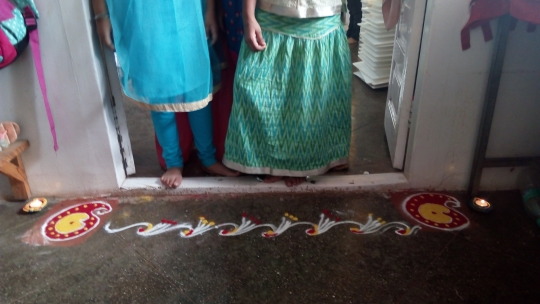
Ich in meinem Saree:
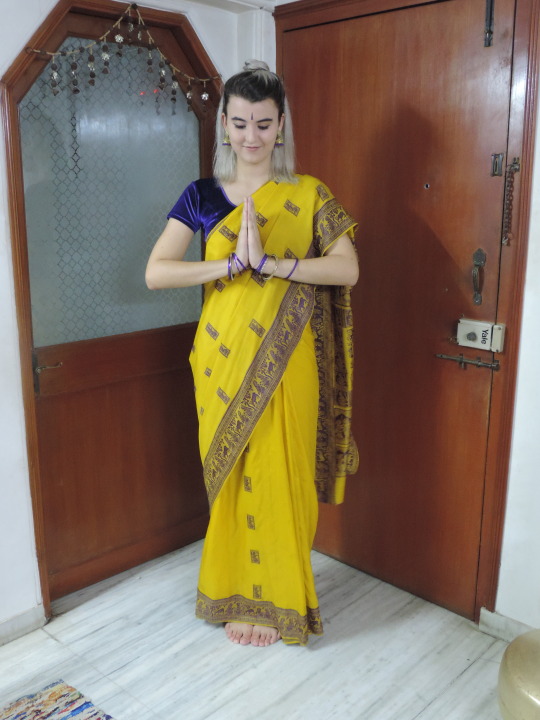
The golden spiral:

Sehr ihr die ganzen Farben? Wunderschön!

Das kleine Tischchen und das Gebetbuch:
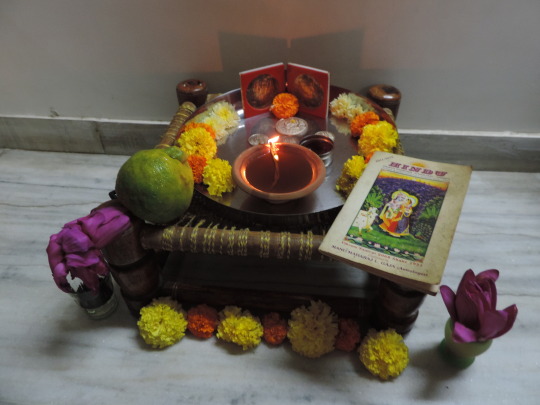

1 note
·
View note
Photo
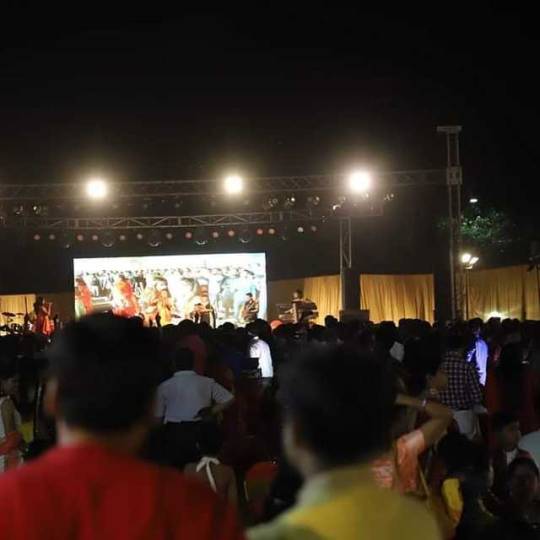
Dandiya Night Navratri festival - World Wide College Navratri festival is just few days away! On this auspicious festival, devotees worship Goddess Durga. The word ‘Navratri’ mans ‘nine nights’ in Sanskrit, wherein ‘nava’ means nine and ‘ratri’ means nights. Navratri is celebrated for nine days and nince nights. During this days, nine different forms of Devi’s are worshiped. Dandiya Night: Dandiya Raas is the basically traditional folk dance of Gujarat & Rajasthan, and is associated with scenes of Holi, and lila of Krishna and Radha. Along with Garba, it is the featured dance of Navratri evenings. The word “Raas” comes from the Sanskrit word “Rasa”. The origins of Raas can be traced to ancient times. Lord Krishna performed Rasa lila”. The Dandiya Raas dance: There are several forms of Raas, but “Dandiya Raas”, performed during Navaratri in Gujarat is the most popular form. Other forms of Raas include Dang Lila from Rajasthan where only one large stick is used, and “Rasa lila” from North India. Raas Lila and Dandiya Raas are similar. Some even consider “Garba” as a form of Raas, namely “Raas Garba”. In Dandiya Raas men and women dance in two circles, with sticks in their hands. #patry #dandiya😍 #worldwidecollege (at Lucknow, Uttar Pradesh) https://www.instagram.com/p/B3SNW4qA0iW/?igshid=mq963apfrw9
0 notes
Text








#the sims 4#sims 4#ts4#high school years#daniella torrez#lucy torrez#oscar torrez#felix torrez#maribel torrez#art torrez#lila nava
74 notes
·
View notes
Photo

Dandiya Night Navratri festival - World Wide College Navratri festival is just few days away! On this auspicious festival, devotees worship Goddess Durga. The word ‘Navratri’ mans ‘nine nights’ in Sanskrit, wherein ‘nava’ means nine and ‘ratri’ means nights. Navratri is celebrated for nine days and nince nights. During this days, nine different forms of Devi’s are worshiped. Dandiya Night: Dandiya Raas is the basically traditional folk dance of Gujarat & Rajasthan, and is associated with scenes of Holi, and lila of Krishna and Radha. Along with Garba, it is the featured dance of Navratri evenings. The word “Raas” comes from the Sanskrit word “Rasa”. The origins of Raas can be traced to ancient times. Lord Krishna performed Rasa lila”. The Dandiya Raas dance: There are several forms of Raas, but “Dandiya Raas”, performed during Navaratri in Gujarat is the most popular form. Other forms of Raas include Dang Lila from Rajasthan where only one large stick is used, and “Rasa lila” from North India. Raas Lila and Dandiya Raas are similar. Some even consider “Garba” as a form of Raas, namely “Raas Garba”. In Dandiya Raas men and women dance in two circles, with sticks in their hands.#happyevent #indianfestival #dandiyanight #dandiya #worldwidecollege #dandiya😍 #lucknowcity (at Lucknow, Uttar Pradesh) https://www.instagram.com/p/B3SND59AGrX/?igshid=1v0hi5ouxixrc
0 notes
Photo
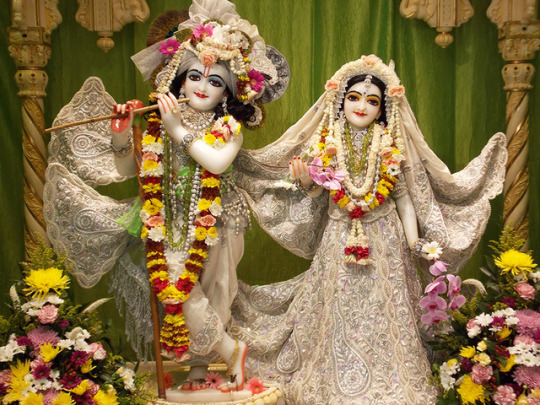

Sri Manah-siksa
Raghunatha Dasa Goswami
“Instructions to the Mind”
Text 1
gurau gosthe gosthalayisu sujane bhusura-gane
sva-mantre sri-namni vraja-nava-yuva-dvandva-sarane
sada dambham hitva kuru ratim apurvam atitaram
aye svantardhatas catubhir abhiyace dhrta-padah
O Mind, I grasp your feet and beg you with sweet words: Please cast away all hypocrisy and develop intense, unprecedented love for my spiritual master, Vrajabhumi, the people of Vraja, the Vaisnavas, the brahmanas, the Gayatri mantra, the holy name, and the transcendental shelter that is the fresh young couple of Vraja, Radha and Krsna.
Text 2
na dharmam nadharmam sruti-gana-niruktam kila kuru
vraje radha-krsna-pracura-paricaryam iha tanuh
saci-sunum nandisvara-pati-sutatve guru-varam
mukunda-presthatve smara padam ajasram nanu manah
O Mind, don’t concern yourself with the pious and impious deeds described in the Vedas. Rather, intently serve Sri Sri Radha-Krsna in Vraja. Always remember that Lord Caitanya is the son of Maharaja Nanda and that my guru is most dear to Lord Mukunda.
Text 3
yadiccher avasam vraja-bhuvi sa-ragam prati-janur
yuva-dvandvam tac cet paricaritum arad abhilase
svarupam sri-rupam sa-ganam iha tasyagrajam api
sphutam premna nityam smara nama tada tvam srnu manah
O Mind, just listen to me! If you desire to reside in Vraja birth after birth, and if you desire to directly serve the divine youthful couple there with great attraction, then with intense love always remember and bow down to Srila Svarupa Damodara Gosvami; to Srila Rupa Gosvami and his elder brother, Srila Sanatana Gosvami; and to all their associates and followers.
Text 4
asad-varta-vesya visrja mati-sarvasva-haranih
katha mukti-vyaghrya na srnu kila sarvatma-gilanih
api tyaktva laksmi-pati-ratim ito vyoma-nayanim
vraje radha-krsnau sva-rati-mani-dau tvam bhaja manah
O Mind, give up friendship with nondevotees, which is nothing but a prostitute who will steal the treasure of your heart–your desire to serve Radha-Krsna. Don’t listen to talks of impersonal liberation, which are a tigress who devours everyone. You should even give up attraction for Lord Narayana, which leads to the world of Vaikuntha. Instead, O mind, just worship Sri Sri Radha-Krsna in Vraja, for They bestow upon their worshipers the jewel of pure love for Themselves.
Text 5
asac-cesta-kasta-prada-vikata-pasalibhir iha
prakamam kamadi-prakata-pathapati-vyatikaraih
gale baddhva hanye ’ham iti bakabhid vartmapa-gane
kuru tvam phutkaran avati sa yatha tvam mana itah
The highwaymen of lust and his friends have bound me around the neck with the painful, horrible, powerful ropes of many wicked deeds. O mind, please scream out to the devotees of Krsna, the killer of Baka, “I am being killed!” Then He will save me.
Text 6
are cetah prodyat-kapata-kuti-nati-bhara-khara-
ksaran-mutre snatva dahasi katham atmanam api mam
sada tvam gandharva-giridhari-pada-prema-vilasat-
sudhambhodhau snatva svam api nitaram mam ca sukhaya
O Mind, why do you burn us both by bathing in the urine trickling from the ass of great deviousness and hypocrisy? Instead, you should delight us by eternally bathing in the glistening nectar-ocean of pure love for Sri Sri Gandharva-Giridhari (Sri Sri Radha-Krsna).
Text 7
pratisthasa dhrsta svapaca-ramani me hrdi natet
katham sadhu-prema sprsati sucir etan nanu manah
sada tvam sevasva prabhu-dayita-samantam atulam
yatha tam niskasya tvaritam iha tam vesayati sah
as long as the impudent untouchable woman of the desire for fame dances in my heart, why should pure love for Radha-Krsna touch me? O mind, continuously serve my spiritual master, the leader of those who are dear to the Lord. Then my master will quickly kick out that harridan and allow that pure love to enter.
Text 8
yatha dustatvam me darayati sathasyapi krpaya
yatha mahyam premamrtam api dadaty ujjvalam asau
atha sri-gandharva-bhajana-vidhaye prerayati mam
tatha gosthe kakva giridharam iha tvam bhaja manah
So That He will mercifully smash my wickedness (even though I am a great rascal), so that He will give me the splendid nectar of transcendental love, and so He will engage me in Sri Radha’s service, please, O mind, with words choked with emotion, worship Lord Giridhari here in Vraja.
Text 9
mad-isa-nathatve vraja-vipina-candram vraja-vane-
svarim tan-nathatve tad-atula-sakhitve tu lalitam
visakham siksali-vitarana-gurutve priya-saro-
girindrau tat-preksa-lalita-rati-datve smara manah
O Mind, please meditate on Krsna, the moon of Vraja forest, as the Lord of my controller, Srimati Radharani. And please meditate upon Srimati Radharani, the queen of Vraja forest, as Krsna’s controller. Also please meditate upon Lalita as the peerless friend of Radha and Krsna, Visakha as the guru who teaches Them many things, and Radha-kunda and Govardhana Hill as two places the mere sight of which bestows charming transcendental love for the divine couple.
Text 10
ratim gauri-lile api tapati saundarya-kiranaih
saci-laksmi-satyah paribhavati saubhagya-balanaih
vasi-karais candravali-mukha-navina-vraja-satih
ksipaty arad ya tam hari-dayita-radham bhaja manah
O Mind, please worship Lord Hari’s beloved Radha. with the splendor of Her beauty She makes Rati, Gauri, and Lila burn with envy, with the power of Her good fortune She defeats Saci, Laksmi, and Satyabhama, and with Her ability to control Krsna She completely eclipses Candravali and the other pious young girls of Vraja.
Text 11
samam sri-rupena smara-vivasa-radha-giribhrtor
vraje saksat-seva-labhana-vidhaye tad-gana-yujoh
tad-ijyakhya-dhyana-sravana-nati-païcamrtam idam
dhayan nitya govardhanam anudinam tvam bhaja manah
O Mind, in order to attain the direct service of the two divine lovers, Sri Sri Radha-Giridhari, in the company of Their friends, every day you must constantly drink, with Sri Rupa Gosvami, the five nectars of worshiping Them, chanting Their names, meditating on Them, hearing about Them, and bowing down before Them, and every day you must worship Govardhana Hill.
Text 12
manah-siksa-daikadasaka-varam etam madhuraya
gira gayaty uccaih samadhi-gata-sarvartha-tati yah
sa-yuthah sri-rupanuga iha bhavan gokula-vane
jano radha-krsnatula-bhajana-ratnam sa labhate
These eleven excellent instructions to the mind grant all spiritual benedictions. A person who stays with the devotees, follows Srila Rupa Gosvami, and with a sweet voice loudly sings these eleven verses will attain the matchless jewel of direct service to Sri Sri Radha-Krsna in the forest of Gokula
(Photos Of Their Lordships Sri Sri Radha Radhanath & Sri Caitanya at ISKCON Temple Of Understanding Chatsworth Durban South Africa)
Preaching To My Mind

Audio Lectures by His Holiness Bhakti Visrambha Madhava Swami
https://s3.amazonaws.com/vihe/Manah_Siksa/Manah%20Siksha01.mp3
https://s3.amazonaws.com/vihe/Manah_Siksa/Manah%20Siksha02.mp3
https://s3.amazonaws.com/vihe/Manah_Siksa/Manah%20Siksha03.mp3
https://s3.amazonaws.com/vihe/Manah_Siksa/Manah%20Siksha04.mp3
https://s3.amazonaws.com/vihe/Manah_Siksa/Manah%20Siksha05.mp3
https://s3.amazonaws.com/vihe/Manah_Siksa/Manah%20Siksha06.mp3
https://s3.amazonaws.com/vihe/Manah_Siksa/Manah%20Siksha07.mp3
https://s3.amazonaws.com/vihe/Manah_Siksa/Manah%20Siksha08.mp3
https://s3.amazonaws.com/vihe/Manah_Siksa/Manah%20Siksha09.mp3
https://s3.amazonaws.com/vihe/Manah_Siksa/Manah%20Siksha10.mp3
https://s3.amazonaws.com/vihe/Manah_Siksa/Manah%20Siksha11.mp3
https://s3.amazonaws.com/vihe/Manah_Siksa/Manah%20Siksha12.mp3
https://s3.amazonaws.com/vihe/Manah_Siksa/Manah%20Siksha13.mp3
https://s3.amazonaws.com/vihe/Manah_Siksa/Manah%20Siksha14.mp3
https://s3.amazonaws.com/vihe/Manah_Siksa/Manah%20Siksha15.mp3
https://s3.amazonaws.com/vihe/Manah_Siksa/Manah%20Siksha16.mp3
https://s3.amazonaws.com/vihe/Manah_Siksa/Manah%20Siksha17.mp3
https://s3.amazonaws.com/vihe/Manah_Siksa/Manah%20Siksha18.mp3
https://s3.amazonaws.com/vihe/Manah_Siksa/Manah%20Siksha19.mp3
https://s3.amazonaws.com/vihe/Manah_Siksa/Manah%20Siksha20.mp3
Source: http://www.vihe.org/audio_lectures.html#

Seminar By Her Grace Mataji Urmila devi dasi
Part 1
https://youtu.be/Ikh1QHGOvhw
Part 2
https://youtu.be/NVVaRrWIexQ
Part 3
https://youtu.be/RPAoRdngJME
1 note
·
View note